I made a backpack and you can too!
I recently designed and sewed a backpack for my toddler. It was fun and not too hard. In this blog post, I will walk you through all the steps from design to construction, explaining my thought process at each step. You can follow my process to create a simple and functional toddler backpack, or use this as inspiration to make your own backpack customized to your needs and preferences.
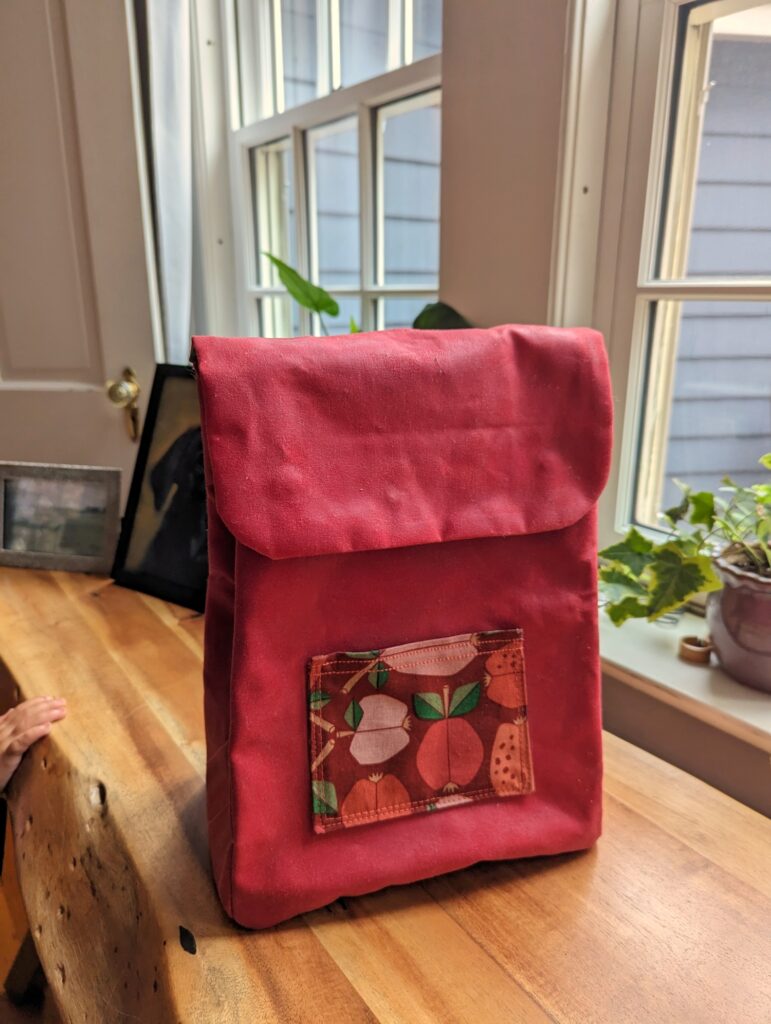
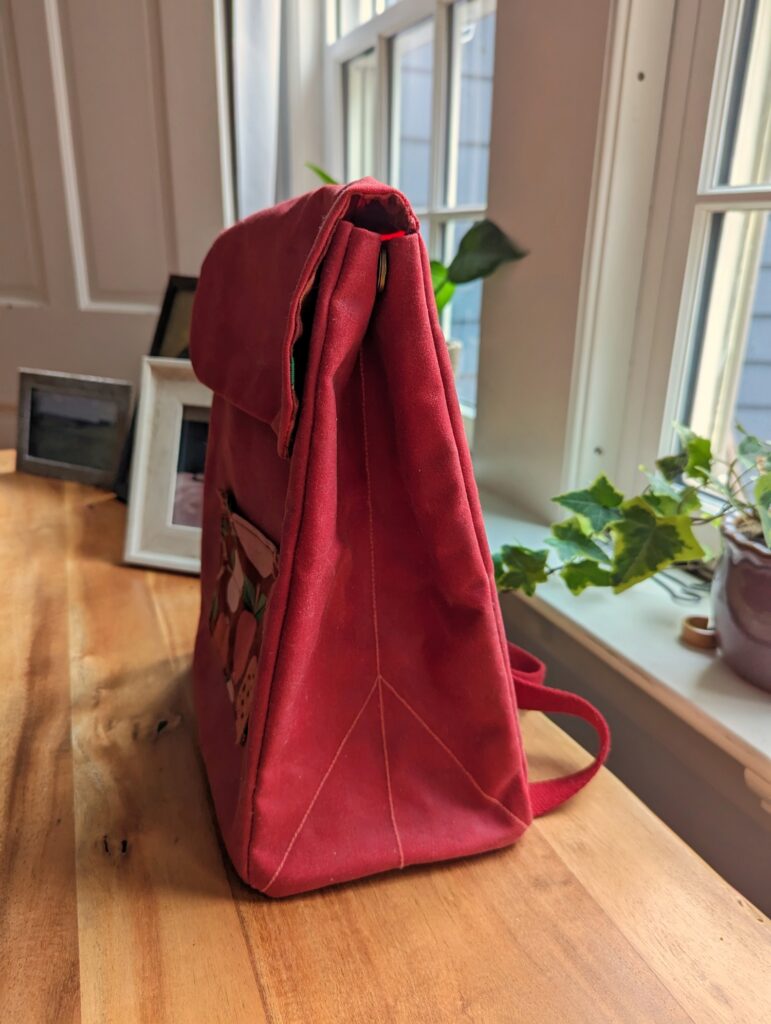
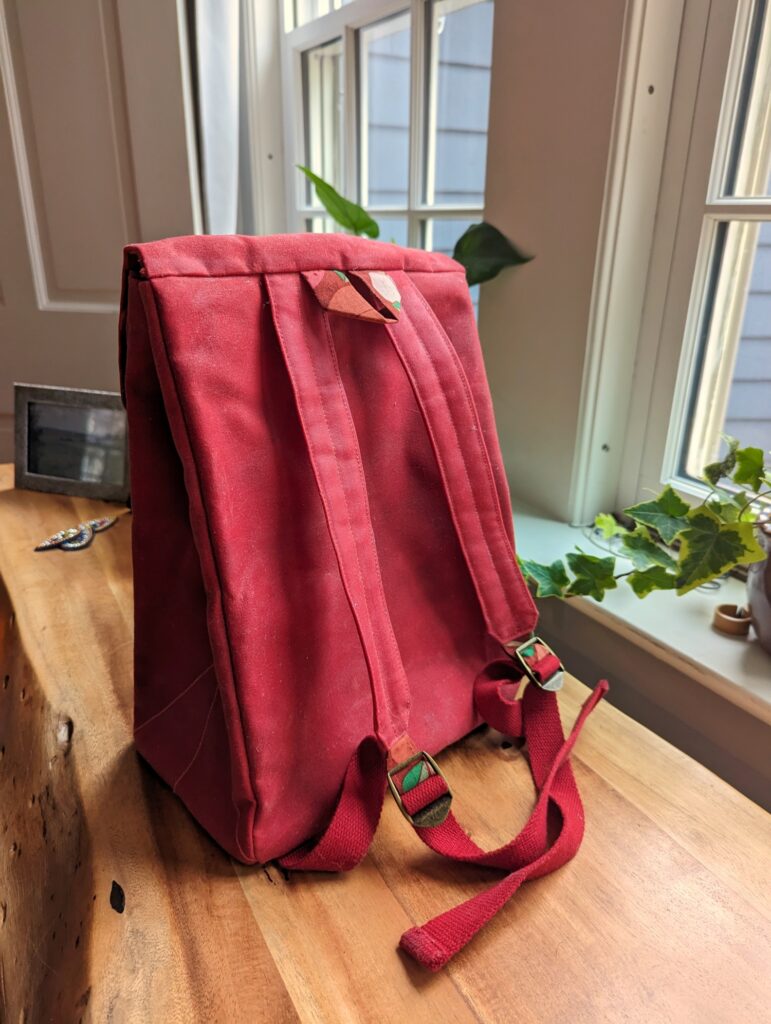

This is a simple backpack, made from mostly rectangular panels. Inside, the backpack has one large pocket – sized to fit a lunchbox, water bottle, and maybe a spare change of clothes or a hat and mittens – and a second, flat pocket sized to fit US letter paper. The large interior pocket also has little “scrunchie” bands to hold a water bottle and thermos upright. The outside of the backpack has a decorative patch pocket, a foldover top, adjustable straps, and a loop to hang it from.
SUPPLIES | DRAFTING | CONSTRUCTION | FINISHING | TECHNIQUES
Supplies
Materials
- Main fabric
- I bought 2 yards of a 55” 10oz duck canvas and had very little left
- I used a waxed canvas and found it very difficult to work with. Personally, I would not use pre-waxed canvas again.
- Lining / contrast fabric
- I bought 4 yards of a 44” lighter weight canvas and had enough left that I think I might have been able to use 3 yds
- Bias binding
- I used cotton twill tape. You can also make bias binding from your lining fabric or use premade bias binding.
- You need a final width of about twice your seam allowance, so about 0.75” for a ⅜” seam
- You need enough length for all four vertical seams, plus the perimeter of the bottom panel, plus a little extra on all the ends to fold over. If you do the same size I did, this works out to about 2.5 yards.
- Cotton batting or interfacing
- I bought 2 yds but I think I used less than 1 yard.
- Slider buckles
- I used these from Sallie Tomato.
- You could use double D rings instead, or make fixed length straps.
- Webbing
- I used exactly 1 yard of 1”/25mm cotton webbing.
- Fasteners
- I used 4 magnetic snaps: one set on each of the side panels to hold them folded, and two to hold the top flap down. (I used these snaps from Sallie Tomato.)
- You could also use buttons, regular snaps, velcro, fabric ties, buckles, clasps…
- Elastic
- This is for the scrunchie pieces that hold water bottles/containers upright, the amount will depend on your design choices.
- Thread
- I used both a matching and a contrasting thread.
Tools
- Sewing machine and needles
- You might find it helpful to have an edgestitch foot or a seam guide foot for some of the steps, and I also found myself wishing I had an even-feed foot.
- Iron
- Clear ruler with seam allowance markings
- I have this one, which I like because it has a ⅜” mark.
- Fabric marker or chalk
- Pins
- Use old pins that you don’t mind bending, because some of the layers get pretty thick
- Clips
- These clips are much easier for bias binding than pins
Drafting & cutting
Before you draw your pattern pieces, take some time to think about what you want the backpack to hold and how you want it to fasten. If there are specific objects you want to carry in the backpack, measure them! If you are making the backpack for a young child, think about what kinds of fasteners they know how to use. If you are making big changes from my design, then draw a couple pictures of your design – front view, side view, maybe an “exploded” view of the various pattern pieces.
In this section, I will walk you through my backpack design one pattern piece at a time. I give measurements in inches, but you can easily convert each measurement to the nearest half centimeter. The photo below shows all of the pattern pieces laid out to illustrate their relationship to each other, and each section will include a (not to scale!) sketch of the pattern piece.

I made my pattern pieces with no seam allowance and used my ruler to draw the seam allowance on the fabric, but you may prefer to add seam allowances to your paper pattern pieces before you cut them out. When I talk about measuring from the edge of a pattern piece to add markings, I mean measuring from the seam line/finished edge of the piece, before seam allowances are added. Unless otherwise noted, I used a ⅜” seam allowance.
FRONT/BACK | PATCH POCKET | MIDDLE & SCRUNCHIES | SIDE | BOTTOM | TOP | STRAPS & LOOP
Front and back panels
The front and back panels are the same shape: a 9.5” by 12.5” rectangle. You can use the same pattern piece with two sets of markings, or you can make two pattern pieces. Mark the center at the top and bottom for both panels.
For the back panel, you need marks for the straps and the hanging loop. The size and location of these marks will depend on the size of the straps and loop. I made the top of the straps 1.5” wide, and placed them so that the inner edges were 0.5” out from the center mark. Measuring across the top from the left, this means: a mark for the outer edge of the strap at 2.75”, a mark for the inner edge of the strap at 4.25”, the center mark at 4.75”, a mark for the inner edge of the second strap at 5.25”, and a mark for the outer edge of the second strap at 6.75”. I used the same marks for the inner edges of the hanging loop. At the bottom of the panel, you need marks for the webbing portion of the straps. My webbing was 1” wide, and I placed it ⅜” in from the outer edges of the panel.
For the front panel, you need markings for the patch pocket. Make your patch pocket pattern piece (see below), hold it up to get a rough position, and then measure to center it. My patch pocket was 5.5” wide by 4” tall, and I placed it 2” up from the bottom of the panel and 2” in from the sides. You also need marks for the snaps (or other fasteners). I used ½” magnetic snaps, with the center placed 2.5” down from the top edge and 1 ⅝” in from the outer edges. This placement worked fine, although I might round up to 2” in from the outer edges next time.

Add seam allowance and cut one back panel from the main fabric. You could line this panel if you want to, but I didn’t.
Add seam allowance and cut one front panel from the main fabric and one from the lining fabric. I lined this panel to hide the inside of the snaps, but depending on what kind of fastener you’re using you may not need to. If you do not line this panel, you probably want to either increase the seam allowance on the top edge (to make it easier to fold over and hem), or add a facing along the top.
Patch pocket
I made my patch pocket 5.5” by 4”, which works as a decorative pocket, but is maybe a little too small to be very useful. Make whatever size pocket you like, and adjust the patch pocket markings on the front panel accordingly.
Add seam allowance and cut two patch pocket pieces from the lining fabric for a contrasting pocket from a lighter weight fabric. If you want to make the patch pocket from a heavier fabric, it might be easier to do a single layer patch pocket, in which case you might also want to use a larger seam allowance on the top edge.
Middle panel and scrunchies
When the backpack is finished, the middle panel should be a little shorter than the back panel, to allow access to the back pocket. I used the same pattern piece for the middle panel as for the front and back panels, and then just scooted it down a bit and trimmed the seam allowance when assembling the backpack, but it might be wiser to make a separate, shorter pattern piece, say 9.5” by 12.25”. Mark the center along the top and bottom edges (4.5” in from the sides).
If you are making the “scrunchie” pieces to hold a water bottle or thermos, you will need to design these pieces and then make placement marks for them on the middle panel.
In my case, I had a thermos and a sippy cup of similar size, so I could hold them with a single scrunchie piece attached at the sides and the center. If your objects are different sizes, you might need separate pieces for them, or your pieces might need to be asymmetric.
I laid my objects down on paper the way I wanted to arrange them in the backpack, marked approximately where the scrunchie pieces should attach, and then measured from mark to mark both flat on the paper (to get the placement markings for the middle panel) and around the containers (to get the length of the scrunchie pieces, see photo below).

The measurement around my containers was about 9”. The elastic part of the scrunchie should be shorter than the measurement around the container, so that the elastic will have some tension when the container is in it. I used 8” of elastic on either side, but this will depend on the stretch of your particular elastic. To get 8” of elastic on each side, I cut about 17.5” of elastic and marked the center and 8” away from it on either side, then trimmed the extra off later when sewing it.
The fabric part of the scrunchie should be about 1.5 times as long as the measurement around the object, so in my case, about 13.5” on either side of the center. It should also be at least twice as tall as the width of your elastic. My scrunchie pattern piece is a 2” by 13.5” rectangle, and I cut it on the fold to make a 2” by 27” long strip, with the center marked.
For the placement markings on the middle panel, I put the center of my scrunchie piece 7” down from the top edge of the panel, centered horizontally (so 4.75” in from the sides). The sides of the scrunchie are attached along the same horizontal line, 3” out from the center.
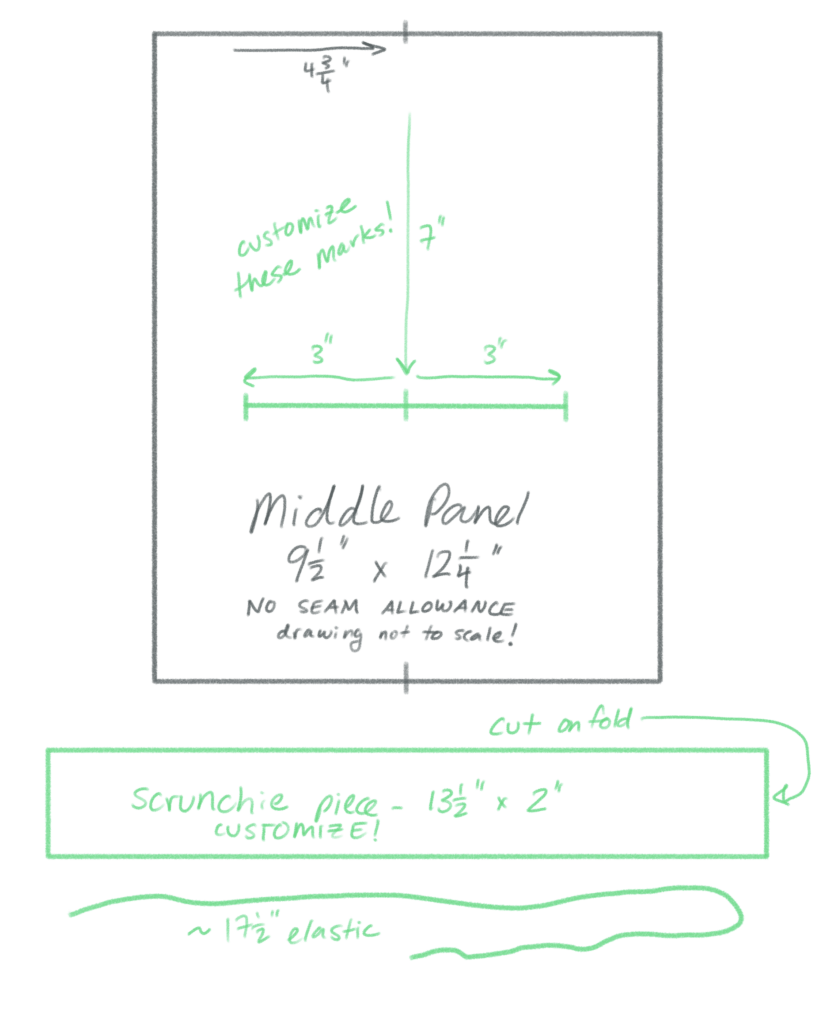
Add seam allowance and cut two middle panels from the lining fabric, and one (with no seam allowance) from cotton batting or interfacing. Add seam allowance and cut scrunchie pieces from lining and elastic.
Side panels
The side panels are 6” by 12.5” rectangles. If you want to do the same paper bag fold decorative stitching that I did, mark the (vertical) center line (3” in from the sides), then mark a dot on the center line 4” up from the bottom, and draw diagonal lines from the bottom corners to that point. If you do not want to do the decorative stitching, just mark the center along the top and bottom edges for alignment.
I added magnetic snaps on these panels to help the fold stay closed. In the photos, you can see that I placed my snaps a little too high. For ½” snaps, I think a better position would be to put the centers 1.5” in from both the top and outer sides. Wherever you place your snaps, make sure they’re symmetric around the center line.

Add seam allowance and cut two side panels from the main fabric. Add seam allowance and cut two side panels from the lining fabric. If you do not use a lining, you likely want to either add a facing or increase the seam allowance on the top edge.
Bottom panel
The bottom panel is a 9.5” by 6” rectangle. Mark the center of all four sides.
You will also need marks for the webbing end of the straps on the side that will connect with the back panel (one of the long sides). These should match the marks on the bottom edge of the back panel. Mine were 1” wide, placed ⅜” in from the outer edges.

Add seam allowance and cut one bottom panel from the main fabric and one from the lining. Cut one bottom panel with no seam allowance from the cotton batting (or interfacing).
Top panel
To draft the top panel, first draw a 9.5” by 6” rectangle and then round the corners on one of the long sides. You can do this with a french curve ruler, or by tracing any appropriately curved object in your house, or by folding in half and drawing the curve by hand. Mark the center on both of the long sides (4.75” in from the sides).
The side with the rounded corners will be the loose, folded over side – let’s call this the bottom edge. The other long side will be attached to the top of the back panel – let’s call it the top edge. The top edge needs markings for the straps and hanging loops – these should match the marks you made on the top edge of the back panel. (Mine are 0.5” out from the center mark.)
You will also need marks for the snaps to close the backpack (unless you are using a different fastener). The horizontal position of these marks should match the marks on the front panel, but the snaps should be lower (farther from the top edge) on the top panel than they are on the front panel, because the top panel needs to fold over all the other panels and the interior space of the backpack. For my ½” snaps, I placed the centers 1 ⅝” in from the outer edges, and 4.5” down from the top edge. This is 1.5” lower than the snap position on the front panel, which seems to give enough length to wrap around the backpack, even when it’s reasonably full, but you may want to play around with this.

Add seam allowance and cut one top panel from the main fabric and one top panel from the lining. This is one panel that I do recommend lining – even if you don’t need to hide snaps, you will need to hide the ends of the straps and hanging loop.
Straps and hanging loop
The loop pattern piece is a 4” by 2” rectangle. Add seam allowance and cut one from the lining fabric (or from the main fabric, if you want it to match).
The backpack strap comes in two pieces. The first piece is a tab that threads through the top of the slider buckle. Before you draft this, measure your slider buckle. My buckles said they were 1”, but the part up top where the tab threads through was slightly narrower. The tab pattern piece should be 2” tall (so that it will fold down to about 1” when it goes through the buckle – this gave me just enough room to keep the buckle out of the way when sewing). For width, you can use either twice the width of the buckle measurement and fold it in half, or you can use the width of the buckle measurement, hem the sides, and let the wrong side of the fabric be hidden by the fold (see picture below).
Add seam allowance and cut two tab pieces from the lining fabric.

To draft the second strap piece, start with a 1.5” x 10.5” rectangle. Mark the center on the top and bottom (short) sides. If you want a line of decorative stitching, then mark the center line. On each side of the strap: mark the bottom edge ¼” in from the outer edge, then mark the side ½” up from the bottom edge, and then connect these two marks with a diagonal line. In other words, cut off a ¼” wide by ½” tall right triangle at each bottom corner, leaving a 1” wide bottom edge to fit the tab piece. If your tab piece was more than a little bit smaller than 1”, you should adjust accordingly.
Add seam allowance and cut four strap pieces from the main fabric. Cut two strap pieces with no seam allowance from the cotton batting (or interfacing).
Construction
My general strategy was to assemble each panel into near-finished condition separately, and then attach the panels to each other. I have broken this into two sections:
ASSEMBLING PANELS | ATTACHING PANELS
The backpack is mostly flat lined, with the seam allowances finished by binding them and the bound seams visible inside the final pocket of the backpack (as opposed to bag lining, where you would assemble one backpack from the main fabric and a separate one from the lining, then put the lining inside the outer so that the seam allowances are hidden between the two layers). The short answer for why I did it this way is that every backpack I looked inside was like that. I think it makes the construction a little easier, and it makes sure the lining stays in place.
Assembling the panels
Front panel
Prepare the patch pocket and attach it to the right side of the main fabric front panel according to the marks. (More detailed instructions here.)
Align the main fabric and lining top panels right sides together, and sew along the top edge only. You can sew all the way across, including in the seam allowances. Open the piece up, press the seam open, and then understitch the lining to the seam allowances.
Open the piece up and attach the snaps at the marked spots on the main fabric front panel (your snaps should come with some sort of instructions). Make sure to use the same side of the snaps on both spots, because these attach to the top panel, not each other.
Iron everything flat with right sides out, and pin or baste the layers together. Set this panel aside until it’s time to assemble the backpack.
Side panels
Take one main fabric side panel and one lining side panel. Align and pin them right sides together, then sew across the top edge only. Understitch the lining to the seam allowance. Repeat for the other side panel.
Open up the layers on one of the side panels. Attach the snaps to the main fabric layer at the marked locations according to the snap instructions. Make sure to use snap pieces that fit together, because these snaps are for holding this panel folded shut. Repeat for the other side panel.
Iron everything flat with right sides out, and pin or baste the layers together. If you’re doing the decorative top stitching along the fold lines, then sew along the marked lines using a contrasting thread, working from top to bottom, with the main fabric facing up so that the magnets don’t stick to your machine. Set this panel aside until it’s time to assemble the backpack.
The picture shows one assembled side panel wrong (lining) side up, and the second side panel right (main fabric) side up. You can see my snaps are placed too close to the top.

Bottom panel
Cut the webbing for the straps into two equal pieces, and then do something to keep the ends from fraying. I had fabric wax, so I melted some and dipped the ends in. You could also zig-zag stitch, overlock, or use an anti-fraying spray.
Align the webbing with the marks on the right side of the main fabric bottom panel and tack them down by sewing across them inside the seam allowance. When aligning the webbing, remember that the longer part of the webbing should be over the body of the panel (see the photo below). If you do it the other way around, so that the long part of the strap is hanging off the edge of the panel, then the strap will end up inside the backpack.
Align all the layers right side out: lining layer with right side down, cotton batting (or interfacing) inside the seam allowance of the lining, main fabric layer with right side up and webbing on top. Baste the layers together and use clips to hold the webbing out of the way. Set this panel aside until it’s time to assemble the backpack.
The first photo shows the bottom panel right (main fabric) side up. Note the placement of the webbing. The second photo shows the bottom panel wrong (lining) side up. The third photo is a side view showing the interfacing layer.

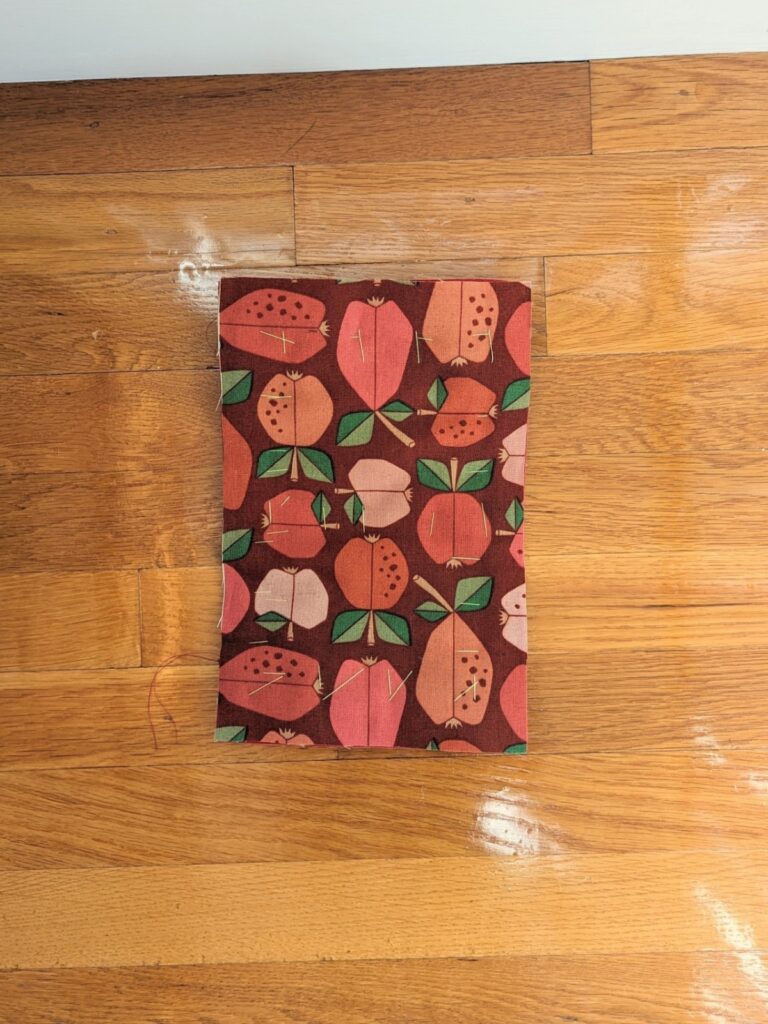

Middle panel
Align the two middle panel layers (both cut from lining fabric) right sides together and sew along the top seam only. You can sew into the seam allowance. Press the seam open.
The next step is to make any scrunchies or pockets you want on this panel, which will depend on your design choices. For mine, I folded and pressed the scrunchie piece in half the long way, with right sides together, and then sewed along the long side to make a tube. I tried to skip a step by not pressing it again with the seam in the center instead of along the edge, but that was a mistake, because the edge with the seam allowance doesn’t scrunch down as tight as the other edge, so the final scrunchies look asymmetrical. Invert the tube, then thread the elastic through and tack it down at the center. At each end: fold the seam allowances in to the wrong side; press; pull the end of the elastic up to the end of the fabric; trim any extra elastic; tuck the elastic in under the fold (see photos below for before/after this step) and pin in place. Open the middle panel pieces up and sew the scrunchie onto the marks on one layer only.
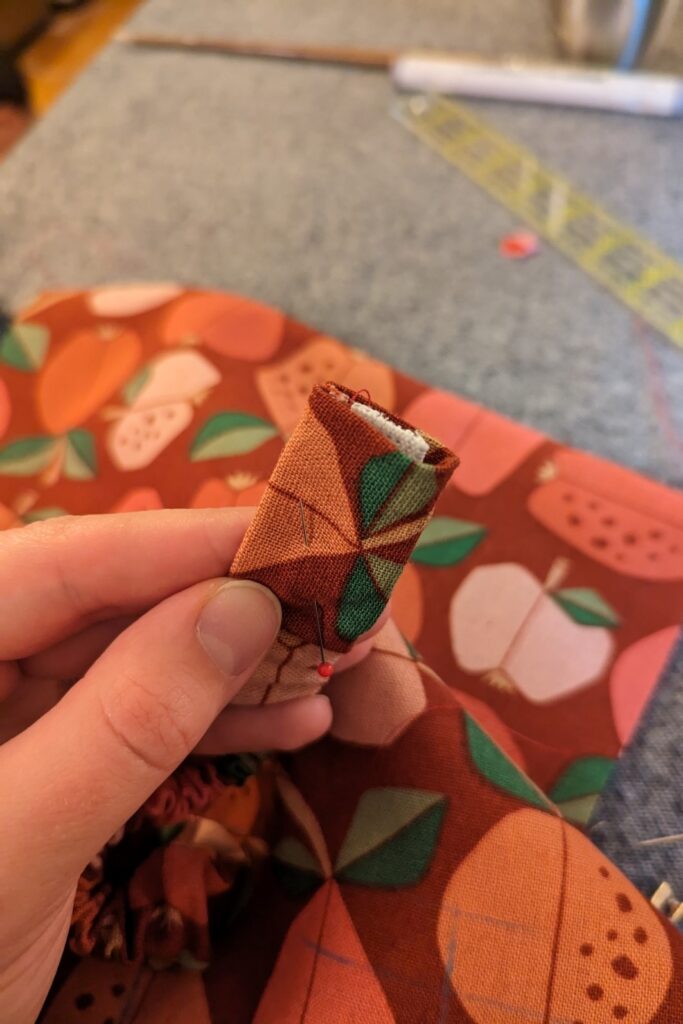

Iron everything flat with right sides out. Insert the cotton batting (or interfacing) piece between the two layers, lining it up with the seam allowance along the sides and bottom. Baste the layers together, and pin or clip the scrunchies out of the way.

Back panel
Align the middle panel assembly from the previous step with the back panel piece, matching the center markings along the bottom edges. The top edge of the middle panel should be below the seam allowance on the top edge of the back panel. The wrong side of the back panel should be touching the side of the middle panel that does not have scrunchies or pockets. Baste the layers together and set this panel aside until it’s time to assemble the backpack.
The first photo shows the assembled back panel “wrong” side up – this is the side that will be in the interior of the backpack. The second photo shows it “right” side up – this is the outside of the backpack.

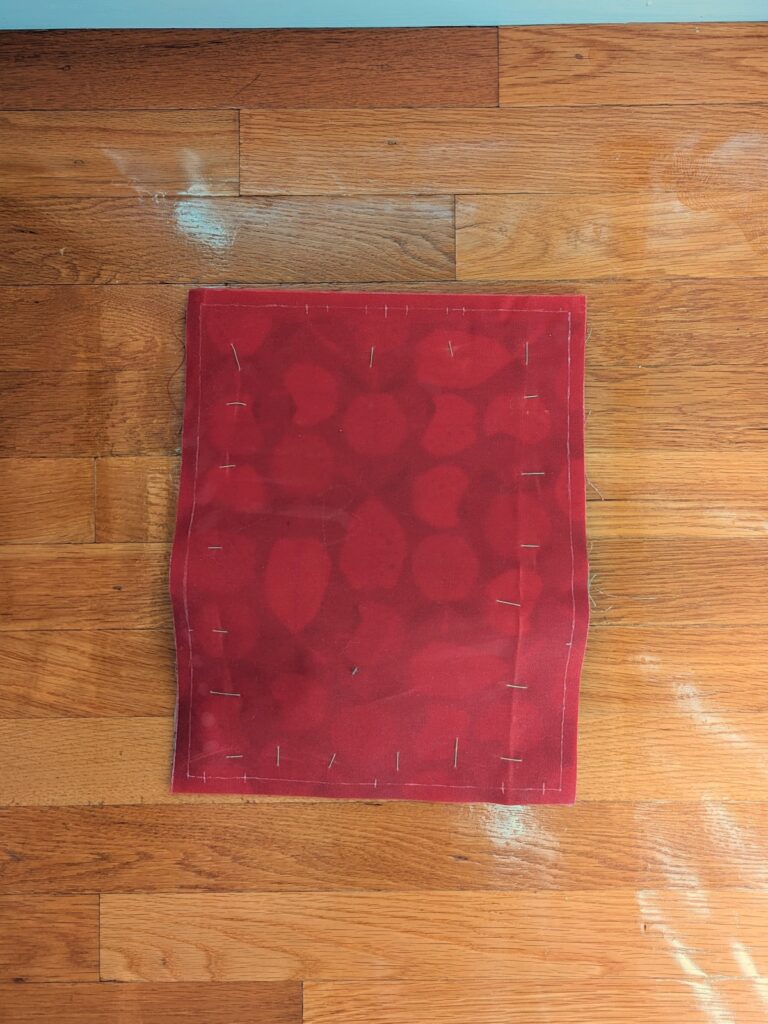
Straps and top loop
First make the hanging loop: Fold the loop piece in half the long way, with right sides together, and press. Sew shut, invert the tube, and press so the seam is in the center instead of the edge. Press into a loop shape (see photo below).
Next, make the tab portion of the straps. For tab style A: fold in half the long way, with right sides together; press; sew shut; invert; and press again with seam in the center. For tab style B: fold seam allowances over; press; and top stitch close to each edge. Repeat for the second tab. Fold the tabs in half, press, and thread through the top of the buckles (see photo below).

For my backpack, I was using canvas that came waxed on both sides. It was basically impossible to invert a tube of this fabric because the wax would stick to itself, so I had to assemble the straps using topstitching. I pressed the seam allowance towards the wrong side along the sides and bottom edge of both straps (not the top edge). I then carefully arranged my layers: one main fabric strap piece with right side down and seam allowances folded in on top; cotton batting layer tucked in under the seam allowance of the previous layer; the tab and buckle assembly with top side down; the second main fabric strap piece with right side up and seam allowances folded in on the bottom. I very very carefully aligned and pinned the layers, starting with the center of the bottom edge, and then top stitched all around, as close to the edge as possible.
If your fabric isn’t waxed, you might be able to sew the long edges with the fabric right sides together and invert. Unless your buckles are small enough to fit inside the straps, you’ll probably still need to press and topstitch the bottom edge. If you try this, please leave a comment telling me how it goes.
If you’re doing the line of decorative stitching, topstitch down the center line after you finish assembling the layers.
Repeat for the second strap.
Top panel
Set the main fabric top panel piece right side up. Align the hanging loop with the marks on the top edge, right side down, and pin. Align the straps with the marks, right side down. Before pinning the straps, rotate them outwards very slightly. Tack the straps and loop down by sewing across them inside the seam allowance.
The first photo shows the assembled top panel right side up – note that the straps and loop are upside down and point in over the top panel, so that they will end up on the outside of the finished backpack. The second photo shows the assembled top panel wrong side up. This is the side where the top panel lining will eventually go, but do not place it there yet!


Attach the snaps to the lining fabric top panel piece according to the snap instructions. These two pieces should each be the same side of the snap, not pieces that fit together. The first photo shows the right side of the top panel lining, the second photo shows the wrong side.


Do NOT sew, pin, or baste the main fabric and lining fabric pieces together. Set both pieces aside until it’s time to attach the top panel to the back panel.
Attaching the panels
I thought it sounded easier to sew all the side seams before attaching the bottom panel, but it was difficult enough that I’m not sure that was best. If you try another order, please leave a comment letting me know how it goes.
Back to sides
Treating the assembled panels as single pieces, where the “right side” is the right side of the main fabric and the “wrong side” is the right side of the lining, align the back panel and one side panel right sides together (taking care to match the top of the side panel with the seam allowance marking on the back panel) and sew from the top down. You can sew in the seam allowance at the top edge, but do not go into the seam allowance at the bottom edge. You can reverse direction to secure the ends, or leave them loose and secure by hand.
Repeat for the other side panel.

Press seams open, and then press again towards the back panel. Bind the seam allowances. Fold the binding over neatly at the top, but leave the bottom end loose. Sew from the top and stop a little bit above the bottom seam allowance, so that the binding can be folded out of the way when sewing the bottom panel on. Press the bound seam allowance in towards the back panel at the top edge.
Top to back
Align the back panel and the main fabric top panel with right sides together and pin or clip. The straps and hanging loop should be between the right side of the back and the right side of the top panel. Make sure the bound seam allowances from the previous step are pinned inside the seam allowance marks on the sides of the top panel. Sew across, taking care not to catch the top of the middle panel.

Unfold and press the seam open, then press it again towards the top panel. Press the straps and loop down towards the back panel.
Take the lining fabric top panel and press the seam allowance on its top edge (the long side without rounded corners) towards the wrong side of the lining fabric. Don’t do this precisely along the seam allowance line – make the seam allowance just a little bit smaller, so that the lining top panel will be just a bit taller than the main fabric top panel, and able to cover the top panel to back panel seam from the previous step.
Pin the top panel lining to the top panel with right sides together and sew around the short sides and bottom (side with rounded corners), leaving the side with the pressed seam allowance open. Clip the corners, press the seam open, and then flip the lining around so that it’s on the inside of the backpack. The inside of your piece should now look like the photo below, except that for the photo I pulled the top panel lining back to show you the seam between the back panel and the main fabric top panel – your lining should just barely cover that seam.

Carefully press and pin (or hand baste) the lining layer so that it covers the seam between the main fabric top panel and the back panel. Turn over and stitch in the ditch to secure the lining.
Front to sides
Align the front panel with one of the side panels, right sides together, and sew from top to bottom. Be careful to match the top edges exactly, and do not sew into the bottom seam allowance. Repeat for the other side.
If you’re using magnetic snaps, they may stick to your machine. You might be able to prevent this just by flipping the fabric and sewing from a different side, but if that doesn’t work, you can baste on a square of mid to heavy weight scrap fabric to cover the magnets temporarily.
You should now have an inside-out bottomless backpack. This is a good time to clip or secure any loose threads so that they don’t get in the way when attaching the bottom.
Bottom to front, sides, back
Align the bottom panel and pin to all four sides. This step gets very unwieldy. I think the easiest thing to do is to pin with the bottom panel up (so that the pins run parallel to the bottom panel), but then turn over and sew with the bottom panel on the bottom and the sides of the bag standing up as vertically as they can. I found it easier and neater to sew four separate seams than to turn the corners. Try not to sew into the seam allowance, because that makes binding the raw edges harder.
Finishing
Binding the raw edges
Bind the remaining side seams, folding the top ends neatly and leaving the bottom ends loose. Trim the side seam bindings so that they don’t go past the bottom panel seam allowance. Then bind the bottom edges, catching the loose ends of the side seam bindings. You can do this with a single piece of binding (see photo below). I found it easier to sew each side separately instead of turning the corners.

Turn the backpack right side out and push the corners out.
Finishing the straps
Now you can undo all the basting and pinning, and hide any loose threads. The final step is to thread the webbing through the buckles, and finish the ends by folding over twice and hemming.
You should now have a backpack! If you made a backpack using this post for guidance, I would love to hear how it went, especially if you figured out an easier way to do any of the steps.
Appendix: Technique tutorials
These are all pretty basic sewing techniques that you can find hundreds of tutorials for online, but I didn’t like the idea of providing incomplete instructions, so I wrote up some mini-tutorials.
Patch pocket
If your patch pocket fabric is not too heavy, I recommend doing a two layer patch pocket. This will work with a quilting cotton or lighter canvas, for example. Cut two patch pocket pieces, and press the top edge seam allowance toward the wrong side on both. Align the pieces right sides together and sew around the other three sides, reversing at the ends to secure the threads. Clip the corners, press the seam allowance to the wrong sides, and then turn it right side out. Push the corners all the way out and then press it flat. If you like a line of decorative stitching at the top of the pocket, stitch the open side closed using contrasting thread and then put this side on top when pinning the pocket to the front panel. If you do not want a line of stitching across the top of the pocket, leave the folded side open and put it on the bottom when you pin the pocket to the front panel, so that it will get closed when you attach the pocket to the front panel. Stitch around the bottom three sides to attach the pocket to the front panel, sewing as close to the edge of the pocket as you can (an edge stitch or rolled hem foot helps).
If you’re making your pocket out of a heavy fabric, like a 10 or 12 oz duck canvas, you might want to do a single layer patch pocket. In this case, you cut a single pocket piece, and begin by pressing the seam allowance to the wrong side of the fabric around all four edges. Make the corners as neat as you can (it may help to clip them a little). Hem the top edge. Line the pocket up with the marks, pin in place, and stitch around the remaining three edges (sides and bottom), reversing at the start and end to secure the threads.
Because the edges of the patch pocket are visually prominent, make sure to do your veryxz best ironing when pressing the pocket seam allowances. Use a spray bottle to get the fabric wet. Fold it very carefully. Iron on the hottest setting your fabric can tolerate until it’s all the way dry. Put a wooden block or rolling pin on top of the edge while it cools.
(Return to patch pocket drafting or front panel assembly)
Understitching
Understitching is a technique for keeping the lining layer from bubbling up and being visible over the edge of the main fabric. I’m not sure it’s really necessary here, because the flat lining is also holding the lining in place, but I really wanted the top edge to look as neat as possible, so I figured understitching wouldn’t hurt.
To understitch, first sew the seam right sides together. Press the seam open, and then press the seam allowances towards the lining side. Then stitch the lining to the seam allowances, just below the seam. When you’re done, you’ll see a line of visible stitching close to the edge of the piece on the lining side, but it should not be visible on the main fabric side.
(Return to front panel assembly)
Basting
Basting is just temporarily sewing something with very big stitches that you remove later. When you’re working with very thick layers, basting is often easier than pinning them together.
As long as your pieces stay aligned and your basting stitches are easy to remove, then you’re doing it right, but there’s a couple common methods. Some people sew next to the seam line using the longest stitch length setting on their machine. I like to baste by hand, aligning the pieces carefully and then taking really big stitches starting in the middle and working out. Leave the ends of the thread loose. Try not to baste right on the seam line, because if you sew your real seam through your basting thread, it will no longer pull right out. (If you do sew through your basting thread, cut the basting thread close to the spot where it’s sewn, use your seam ripper to separate the fibers of the thread, and then pull on the thread from the other side.)
(Return to front panel assembly)
Inverting a tube
Turning a long narrow piece right side out can be difficult, but there’s a couple tricks to make it easier. First, you should turn by pushing the end down the inside of the tube, not by folding it outwards. Second, it helps if you attach a small safety pin, or baste on a long piece of thread like a leash, to give you a way to grab the end when it’s inside the tube. Third, a chopstick often comes in handy.
(Return to middle panel assembly)
Binding
If you want to do a really neat binding, you should probably look for a tutorial on a quilting blog, because I’m sure there’s a lot of tricks I don’t know, but the basic idea is just to wrap something around the raw edges of your seam and sew along it so that both sides of the binding are caught and the edges are encased in the binding. Clips are usually better for holding the binding on than pins.
(Return to attaching the sides to the back)
Stitch in the ditch
“Stitch in the ditch” means sewing right along a previously sewn (and pressed) seam, usually to attach a lining or hold a facing in place. If you do this very carefully, with a well color-matched thread, the stitching ends up being nearly invisible.
Here, we’re using stitch in the ditch to sew down the final side of the top panel lining over the top panel and back panel seam allowances, using the top panel to back panel seam as the “ditch” to sew in. First, press and pin or baste the lining so that it just covers the top panel to back panel seam. Make sure you’re really confident that this edge is lined up correctly and will stay in position, because this side needs to go on the bottom while sewing, so you won’t see if it gets pushed out of place. Once the lining is perfectly positioned and secure, turn the piece over so the lining is on the bottom and sew along the top panel to back panel seam. Go as slowly as needed to make sure the new stitches are exactly in the old seam.
(Return to attaching the top panel to the back panel)
